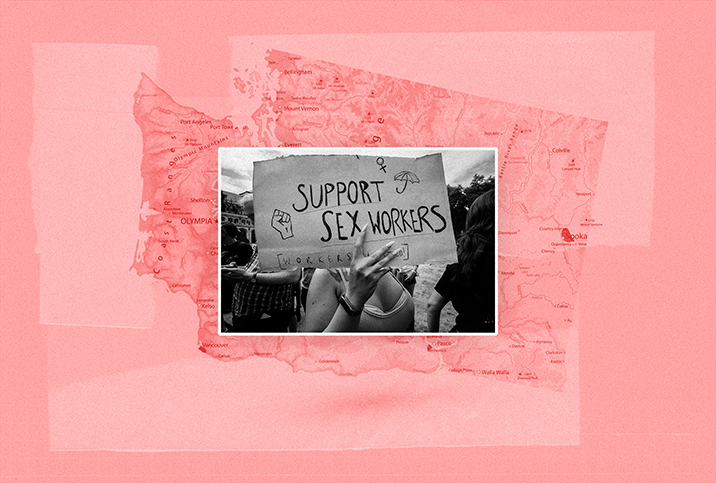A Deeper Approach to Gender-Based Violence

The definition of gender-based violence has evolved over time. For Amy Hill, director of the Silence Speaks program at Storycenter.org, this outward-growing circle is important to best protect those in the most danger.
"Gender-based violence (GBV) is violence perpetrated based on misogyny, homophobia or transphobia—basically, committed because of someone's biological sex, sexual orientation or gender identity," Hill said. "Using [the term] 'gender-based violence' allows us to address violence against women and members of LGBTQI communities together, in a holistic way, while also recognizing the specifics of how violence occurs when directed toward women born as women versus individuals who are LGBTQI."
However, it's not just the gender part of GBV that carries different meanings. Ariel Valdes, education and training coordinator at Jane Doe, Inc. (JDI), adds to the definition.
"There are a number of different ways this violence can be enacted, including via sexual assault, physical assault, emotional abuse, language marginalization, misuse of technology, economic abuse— such as your stable housing or employment being in jeopardy—or withholding needed medication or care," Valdes explained.
Bringing gender-based violence out into the open
The silence and shame that historically permeates the topic of GBV reinforce toxic behaviors and ideas, and uphold a vicious cycle, as speaking against an abuser can have ripple effects on the survivor, their family and their whole community. The risks survivors face by speaking out range from compromising their personal safety and livelihood to the upheaval of community structures if their abuser is a well-established member of society.
Even if a survivor is ready to take on those risks and escape an abusive situation, some may distrust the resources in place to help them. And not without reason.
"Mainstream programs and their services were designed for white, heterosexual women," Valdes said. "Therefore, they do not necessarily meet the cultural and individual needs of men and people who identify as LGBTQ."
GBV exists at an intersection of gender with many other influential factors, such as sexual orientation, sexual identity, race and economic status.
This is particularly problematic since, as Hill and Valdes emphasized, GBV exists at an intersection of gender with many other influential factors, such as sexual orientation, sexual identity, race and economic status.
Although not every GBV resource was built in the way Valdes described, JDI and Storycenter were organized specifically to address the complexity of these issues. They collaborate with other social issue organizations, grassroots organizations and individuals to create strong networks and communities.
Community is central to Hill's Storycenter initiative, Silence Speaks. The program emerged in the mid-2000s, when Hill said she "became frustrated by the overemphasis on either individually based therapeutic approaches or punitive criminal justice approaches," as well as the "Balkanization of issues—that is, child sexual abuse is addressed over here and domestic violence over here. I found greater alignment with international organizations using a public health and human rights approach."
The project started as a domestic program but has since become a global one, using storytelling and participatory media to support GBV intervention and prevention. As the program has grown, its scope has increased as well, now including many human rights issues such as the use of child soldiers and the infringement on indigenous communities' rights.
In Silence Speaks, the survivors, or storytellers, control their narrative. They attend hands-on workshops to create and share their first-person stories in the form of videos, radio pieces and photo essays. The community and solidarity the survivors share are crucial to violence prevention. Silence Speaks has facilitated more than 25 storytelling workshops worldwide, guided by their overarching theme to "listen deeply."
Jane Doe, Inc., is also committed to reinforcing a strong network of organizations and individuals to work together with survivors and communities directly affected by GBV. This network ranges from workshops and training for those looking to help survivors to collaborating with other advocacy groups to provide economic initiatives, including economic empowerment grants.
The White Ribbon Day campaign in Massachusetts—an event specifically for men and boys to join into partnership with women and girls to proactively join the movement to end GBV—is also organized by JDI. In conjunction with this campaign are #ReimagineManhood symposiums, where people can build their skills and knowledge base in service of that goal.
What COVID-19 changed
Storycenter and JDI both rely on in-person support and events to reach those in need and those who can help them. Understandably, the pandemic hindered this ability and created new challenges for the people these organizations sought to help.
"We started offering a number of special free webinars and workshops last spring, and are continuing to do so," Hill said. Silence Speaks also launched a new project during the pandemic, Imagine Another World: India during COVID-19. "This has been a time of such immense uncertainty, change, anxiety and loss that people have relished the chance to connect and speak about what has been on their minds. We have, of course, shifted all of our work to a virtual context and will likely continue to work this way even when it becomes safe to return to in-person gatherings, though we look forward to coming together with groups in real life soon, too."
Valdes and the rest of the staff at JDI saw similar changes, which incited a need to "shift programming and prevention to the online realm for programs to reach their communities." This shift and the pandemic itself exposed what Valdes called "gaps" in the care and outreach for vulnerable populations, including people with disabilities, those in rural areas and those with limited English proficiency.
For more information and to contribute
Most organizations that work to support GBV intervention and prevention—including Storycenter and Jane Doe, Inc.—have volunteer or support opportunities available. You can also visit the VolunteerMatch website, which connects volunteers with opportunities in the U.S. and overseas.
If you or someone you know is experiencing or being threatened with violence, this helpful guide can point you in the right direction.




















